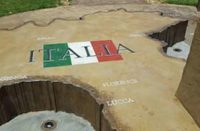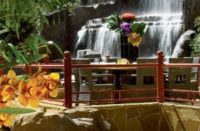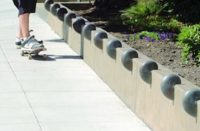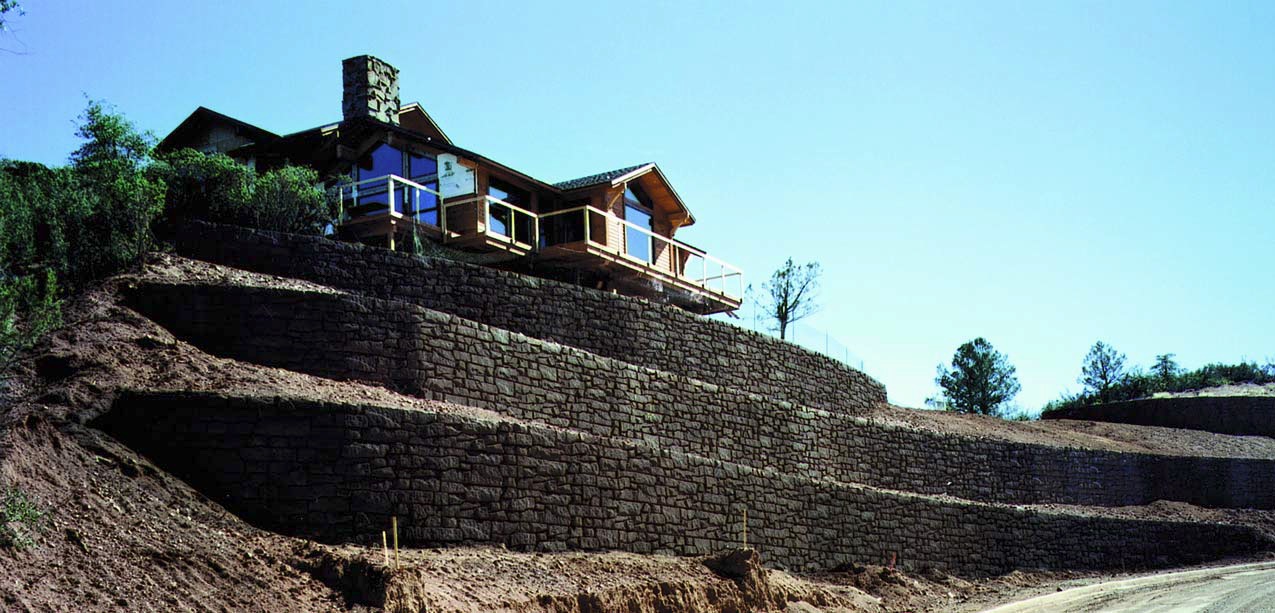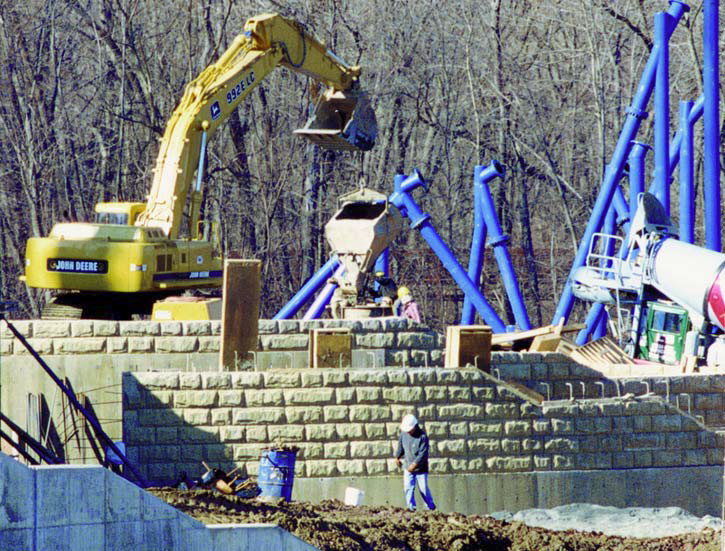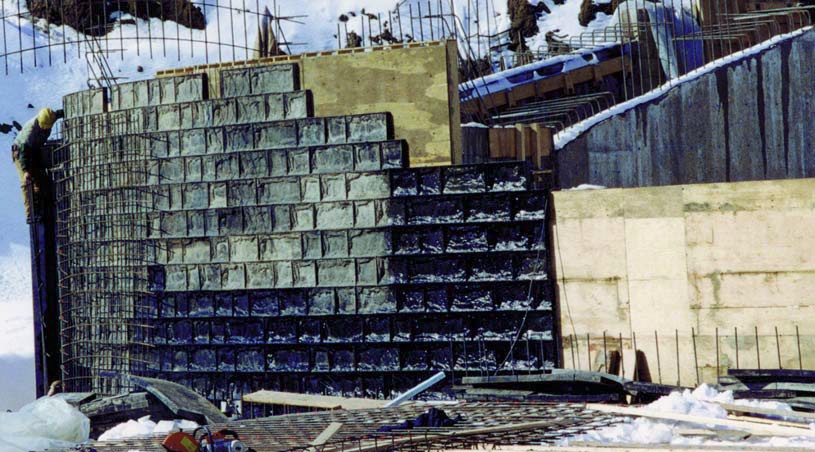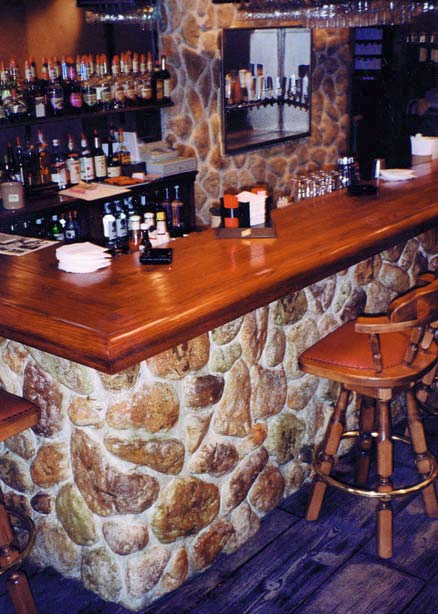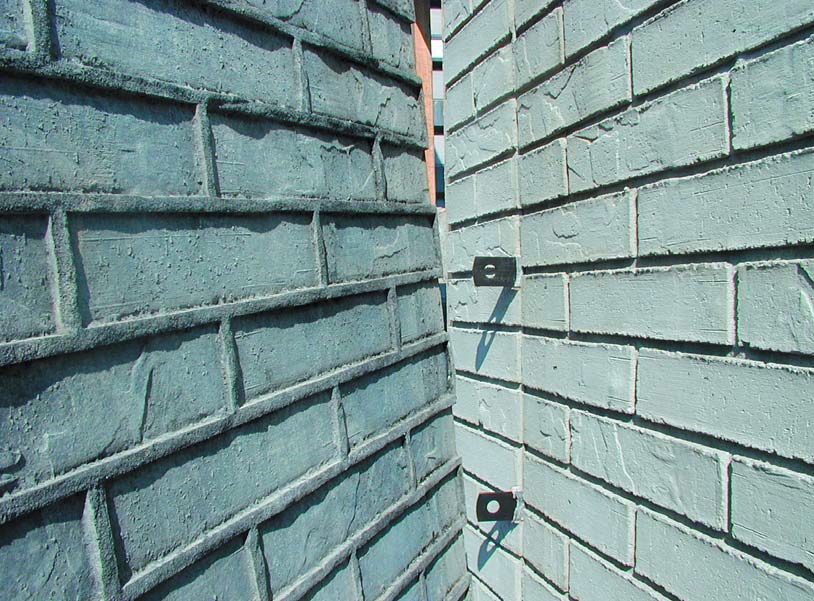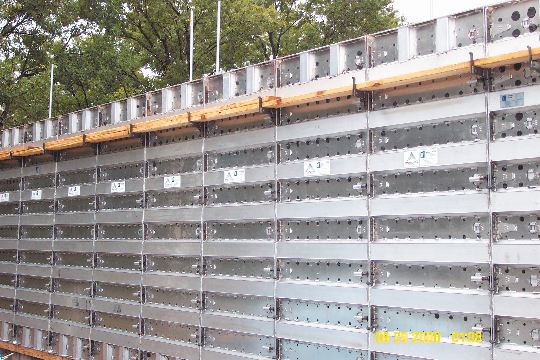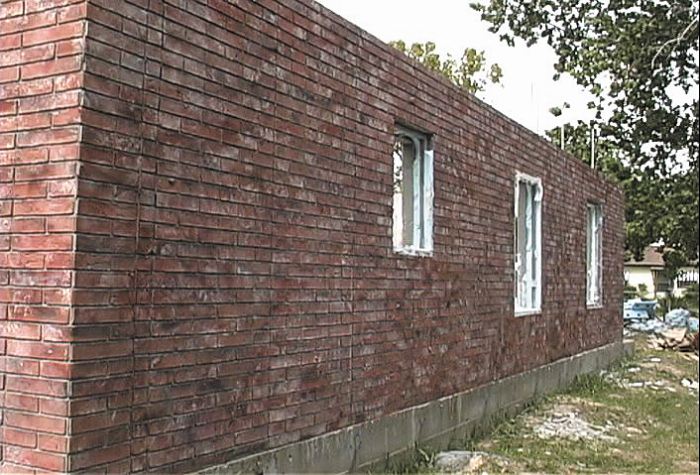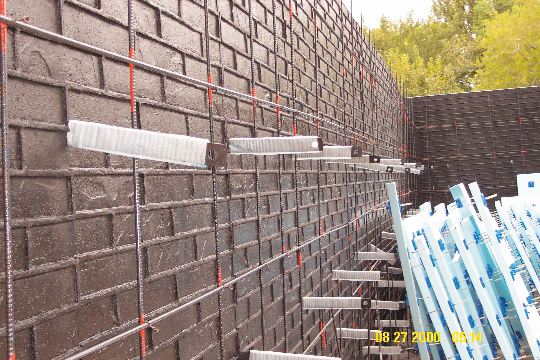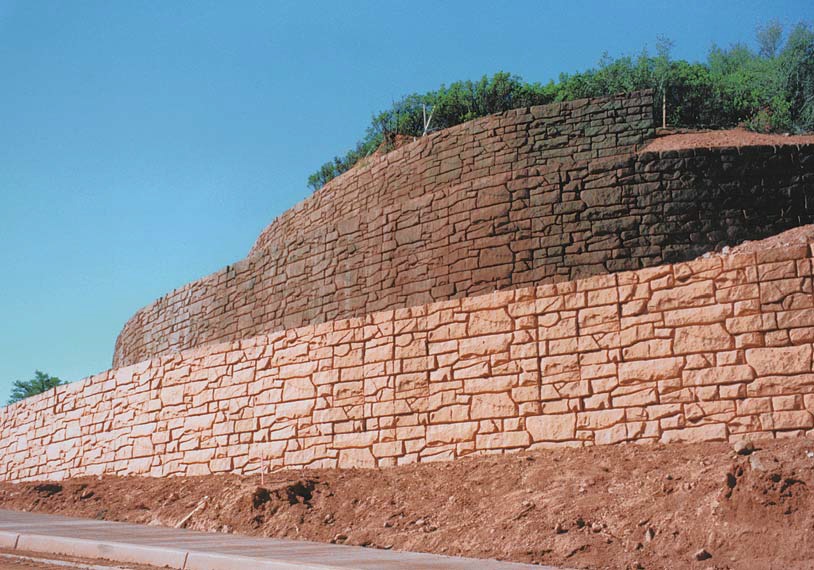Over the years, the popularity of using decorative form liners for forming, stamping and coloring patios, walkways, driveways and numerous other horizontal surfaces to look like brick, flagstone and a variety of other materials has grown. Indeed, it’s often a more economical and hardwearing substitute for the real thing. As a concrete technique, it was only a matter of time before it began climbing the walls.
Today, use of decorative forms and liners mean vertical projects can be structural and nice to look at. Drive down the highway and you’re likely to see several examples: sound barriers and bridges, to name just two.
Decorative Concrete Today
“We do a lot of heavy highway work,” says John Toomey, project manager for Northern Construction in Hingham, Mass. “One out of every 10 bridges [we do] has a patterned design. Patterns, such as exposed aggregate ribbed patterns, make them more aesthetically pleasing.”
In a project for Six Flags New England, Northern Construction used decorative forms for retaining walls and site walls, in addition to stamped concrete. The company used a creative approach for a high-end look, using borders and different colored caps.
Mark Scott, co-owner of Innovative Brick Systems in Boulder, Colo., says his company uses form liners to create natural-looking textures and patterns, but also uses them for custom graphic work. “We did a sound wall project in Baton Rouge, La., in which we pre-cast sections with pelicans, water lilies and other sculpted effects.”
A Variety of Uses
A 3.2-mile-long poured-in-place seawall project was finish at Virginia Beach, Va., in June 2020. Formed into the vertical surface facing the beach are fish, sea turtles and dolphins, as well as the seals of the city and the U.S. Army Corps of Engineers. But the wall is more than just decorative and protective; it’s informative, too! According to Phill Roehrs, coastal engineer with the City of Virginia Beach, “At each street access the number of the street is imprinted, so you know where you are as you walk down the beach.”
Light commercial and residential applications abound. Exposed foundations and ledgers, walls of buildings and homes, retaining and landscape walls, and community entrances are all more visually appealing with decorative forms and form liners. For durability and beauty, a tavern or winery might consider a bar made of poured concrete in a simulated river rock, wood or brick pattern to complement the interior decor.
And don’t forget, the little decorative details that can enhance a larger project. Cameron Morgan, general manager of Pacific Concrete Images in Laguna Hills, Ca., which manufacturers architectural profile form liners, points to swimming pool edges, wall caps, stairs and poured concrete kitchen countertops. “You can bundle forms for larger caps,” he says, not unlike one would stack crown molding. His company’s polyethylene form liners have even been used to construct an outdoor barbecue, complete with concrete eating bar and stools.
Imagination and engineering capability are the only apparent limits to using decorative forms and form liners. Each job dictates which product to use.
A product for every project
“Patterned aluminum forms are more expensive, but they are lightweight and durable,” reports Becky Kennedy, a sales representative with Precise Forms Inc. of Kansas City, Mo. And depending on how well you maintain them, “you can get 2,500 to 3,000 pours,” she adds. Stamping the metal creates the pattern. Precise Forms offers two kinds of brick — smooth and textured — with deep mortars for extra detail, and a ribbed pattern. “A 3-foot wide by 8-foot tall section weighs 83 pounds. Ten-foot high forms are available and they can be stacked,” Kennedy says.
Flexible forms are ideal for pour-in-place projects. With tilt-up applications, the form liners can be as large or as small as the pouring bed requires, according to David Salisbury, president of Polytek Development Corp. of Easton, Pa. “Flexible rubber molds can also be used for architectural elements — brackets, moldings, capitals and more — anything that can’t be done in a rigid form.” Flexible rubber formliners are utilized in both precast applications as well as with GFRC (glass fiber reinforced concrete) that can be sprayed about 3⁄4″ thick to create strong, hollow, light weight concrete castings of highly decorative objects.
“Form liners are light and easy to handle, and are a lot cheaper than a standard form,” says Gale Fife, president of Cobblecrete International of Orem, Utah. If you use 4-foot by 8-foot or 6-foot by 12-foot forms, you won’t need a lot of ties, he explains. “We recommend you stay with a smaller size and stack them. The wall will be stronger and you’ll have less problems.”
Form linings and Designs
When it comes to form liners, you can get any design you want — standard to custom designs. Form liners are an investment up front, but offer savings in time and labor. You may pay $5,000 to $10,000 more for a custom liner, reports Scott, but nothing else would be like it. “On large projects, it’s not a big expense.”
“If the job is engineered and installed correctly, you can’t beat a poured wall, especially one with architectural effects,” touts Mike Lowe Jr., marketing director of Increte Systems of Odessa, Fla. “You save in labor and total life costs. The textures [and patterns] are pulled off real materials — slate, granite, limestone, river stone. Stone is expensive, so this is where form liners are so cost-effective. Installation costs are less expensive compared to veneer”. Plus you don’t have to worry about degradation or veneer delamination, he adds.
Form liners come in various grades, which have different life spans. How many times you need to use the form should be considered, as well as cost. For example, you may only get five to 25 pours out of low-reuse foam forms. If 50 to 60 pours are required, you’ll need a higher quality form. High-reuse rubber forms might be reused 100 or more times, depending on the design or pattern.
New Products
Western Forms Inc. of Kansas City, Mo., and Milestones Inc. of Hudson, Wis., have teamed up to create a hybrid product called Monotex.™ Paul Nasvik, owner and president of Milestones, describes it as a liner and rigid form that work together as a system. “The urethane form is cast into Western’s rigid aluminum forms. Other forming systems, with ties and liners that have to marry to it, can be quite involved. This forming system eliminates the marrying problems.”
Currently, Habitat of Humanity is using the system to build several homes in Houston, Texas. “The main push is working to convey to the housing market that concrete homes can look like traditional homes — and can be done quickly and cheaply,” Nasvik explains. The Monotex forms are said to handle 200 pours per set for exterior walls. The initial production liner system is in a brick pattern, but other texture samples are being made.
New Techniques
Another technique — not quite a mold, not quite a stamp—is showing excellent promise. Michael Allen Sr., owner and president of Allen & Sons Construction Inc. of French Camp, Calif., says his company has developed a texturing roller system for Gomaco concrete extruding machines. Allen calls the proprietary patented process “Slipstone.” The prototype uses a special soft rubber compound on a large roller to imprint the design on the formed concrete as it comes out of the machine.
The process can imprint the three surfaces of a wall — the two faces and the top — and can imprint over visqueen plastic sheeting as it unrolls over the formed concrete. The maximum height for a plain wall extruder is eight feet-nine inches, so that’s the height limitation to date. Community entrance walls, sidewalks, bulkheads, retaining walls and vertical curbs are all ideal applications, according to Allen. “The reason we developed the process is to be competitive in the market. It cuts installation time and you can see up to 47 percent cost savings over standard form liners depending on footage.”
For wall caps, step edges and other similar projects, disposable forms may be just the things you need. Bud Stegmeier, marketing manager of Stegmeier Corp. of Arlington, Texas, explains that his company grinds architectural profiles into polystyrene to create forms, which are simple to attach to the face of a wooden form to create a decorative edge. “The forms are flexible, so they can be pulled away easily. Because they cushion the concrete as you pull the forms away, they protect fragile corners.” The forms can also be compressed into curves.
The coloring process
If the project is in a natural setting, integrally colored concrete can help the structure blend in. It also gives you a base color to expand on. Lowe observes, “Base color is important so you use less stain and accent each stone rather than coloring each stone. It saves time and materials, gives a more realistic look, and you don’t have to worry so much about chipping because it won’t be as noticeable.”
Which integral color you select will depend on what architectural design your concrete will assume. As well as what part of the country you’re in. “You usually want to match up with the natural stones in the area. In the southwest there is a different color scheme than in Florida. New York has a granite stone look. In Philly, there’s bluestone. In Phoenix, stones are more of a tan shade with a little red,” explains Rich Solomon, vice president at Solomon Colors in Springfield, Ill. The north’s stones are typically a darker shade than what you’d find in the south.
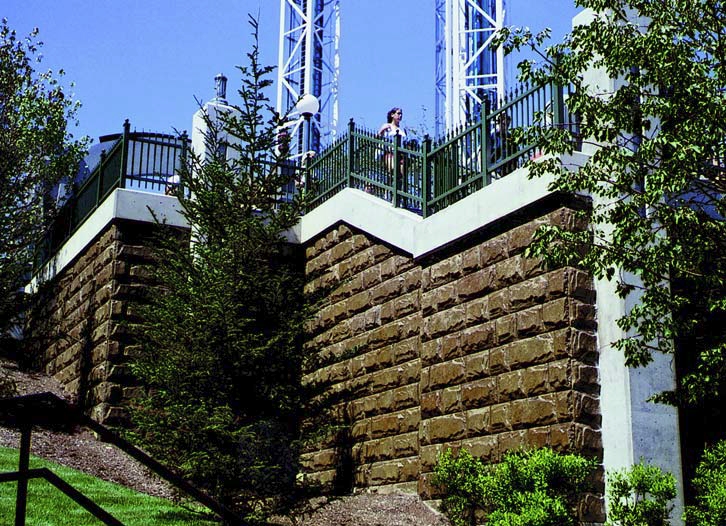 A technique you can use with integrally colored concrete is sandblasting. “With sandblasting, you’re not adding anything, but removing some of the cement paste on the surface. Sandblasting can also expose some of the aggregate—a technique that can give a good look. The type aggregate you use will play into the color.” Solomon says.
A technique you can use with integrally colored concrete is sandblasting. “With sandblasting, you’re not adding anything, but removing some of the cement paste on the surface. Sandblasting can also expose some of the aggregate—a technique that can give a good look. The type aggregate you use will play into the color.” Solomon says.
Not everyone wants to use integral color, however, and integral color alone may not provide the desired effect. Using a variety of methods and materials is common.
Coloring Concrete
Powdered pigments mixed into a release agent [or dusted into the mold] can provide some nice effects. Color hardeners aren’t common on vertical surfaces, but some use them by mixing them with a bonding agents and hand-troweling them on, like a stucco. But caution is given with these customized applications that, if not done properly, it won’t adhere properly. And if moisture bleeds through, the color could pop off. In applying any surface color it is a prerequisite to pressure wash the surface to remove any residual release agent. Sandblast if necessary.
Harlan Baldridge, manager of the decorative concrete division of Cut & Break Construction in Medford, Ore., prefers to mix color hardener into a pancake batter consistency and then spray it onto gray concrete. “A bonding agent is great to use before spraying on the color hardener,” he advises. Baldridge uses a variety of colors to create the effects he wants. “If a native stone has a red basis, I’ll start with a neutral, like cream, then add a sun-baked clay color. I can add black flecks by random bursts of color. I can hand rub to get some of the color off for a tumbled stone look. This also highlights textures of the stone pattern.”
Method Choice is Important
At Chaparral Pines Country Club in Payson, Ariz., Gerald King, concrete operations manager of Pace Pacific in Phoenix, and his crew applied additional color over integrally colored concrete to achieve the effect the client wanted on some 30,000 square feet of structural retaining wall. “We started with integrally colored concrete and added additional color by spraying multiple colors of color hardener,” he explains. They made a presentation mock-up to see what the product would look like. They then purchased color in large volumes to help with consistency. “You have to make sure your client knows [integrally colored concrete] is a natural product and that it can change.” But he points out that using color hardener over it helps camouflage and mask inconsistencies.
Acid stains are also used frequently to color architectural concrete, but be sure to protect yourself if you use them. Wear safety glasses, a respirator, non-absorbent gloves, long sleeved shirt, long pants and work boots. You can apply the stains using a sprayer, sponges or paintbrushes. But always remember to start at the bottom of the wall and work up.
Practice and Patience
No matter what method or combination of methods you use to color your project, it is important to remember that your release agent may affect the results you achieve. Can the release agent leave a residue? Will it prevent good adhesion of color hardener? Will it react with the chemical stain you use? Release agents containing petroleum products can also harm some form liners. Talk with and get recommendations from the form and liner manufacturers. It helps to talk with other contractors that use these forms and learn from their hands-on experiences.
Karl Russell, owner of R&R Poured Walls in Byron, Mich., says working with decorative forms and liners is not complicated, but you have to pay attention. “Practice up front. Don’t sell a job never having done it. Make time and practice in different temperatures.” And practice different techniques. Gaining the know-how can improve business prospects and increase the bottom line, he says. Having happy clients isn’t a bad motive either.
In Virginia Beach, Roehrs reports, “I’ve heard nothing but compliments about our seawall. Most of the tourists are pleased with the esthetics. [Including the custom decoration in the project] was a small additional cost that will reap dividends for years.”
